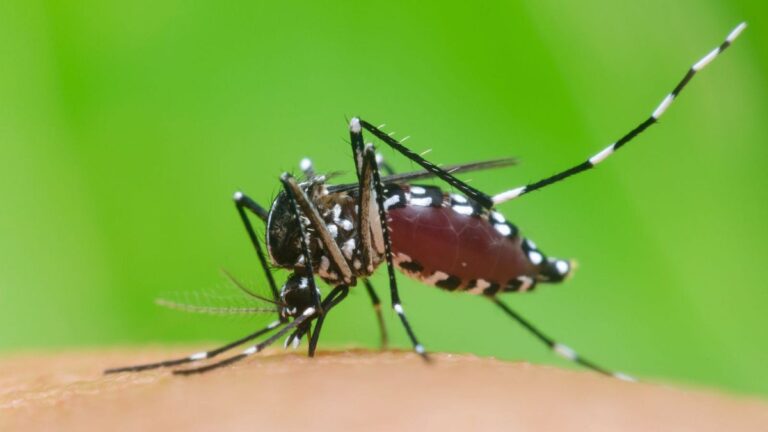Dengue cases almost doubled in the EU last year as climate change created more favourable conditions for vectors.
advertisement
Climate change is causing a surge in outbreaks of mosquito-borne diseases in Europe, according to the latest official figures.
The European Centre for Disease Prevention and Control (ECDC) said this week that there were 130 locally transmitted cases of dengue in the EU last year, but this is set to fall to 71 in 2022.
There has been a recent surge in cases in Europe, with the invasive mosquito species now confirmed in 13 EU member states.
Dengue fever is spread by the Asian tiger mosquito
Dengue fever, also known as broken bone fever because of the severe joint pain it causes, is a potentially fatal viral infection that spreads to people through mosquito bites.
In the 10-year period from 2010 to 2021, a total of only 71 cases were reported across the EU.
“In Europe we already see that climate change is creating favourable conditions for non-native mosquitoes to spread to previously unaffected areas and transmit diseases such as dengue fever to many more people,” said Andrea Ammon, director of the ECDC.
The Asian tiger mosquito (Aedes albopictus), which transmits dengue, chikungunya and Zika viruses, has spread to the north, east and west of Europe, the continent that is warming the fastest, and is now native to 13 countries.
Where in Europe is the Asian tiger mosquito prevalent?
So named because of their black and white striped bodies, these mosquitoes were previously found only in tropical regions but can now be found in Austria, Bulgaria, Croatia, France, Germany, Greece, Hungary, Italy, Malta, Portugal, Romania, Slovenia and Spain.
It has been detected in British ports several times in recent years but does not yet appear to have established itself on the island.
“Increased international travel from dengue-endemic countries will increase the risk of imported infection and, inevitably, the risk of local outbreaks,” Amon said.
This is supported by the latest data from the ECDC: more than 4,900 Europeans contracted dengue while travelling abroad in 2023, the highest number of imported cases since surveillance began in 2008, and up from 1,572 in 2022.
Climate change and the El Niño weather phenomenon are accelerating the spread of dengue fever
Last year saw a record number of dengue cases worldwide, with more than 6.5 million cases reported in over 80 countries and 7,300 dengue-related deaths.
According to the World Health Organization (WHO), there are several reasons for this epidemic: First, the widespread distribution of the dengue-transmitting Asian tiger mosquito, and the yellow fever-transmitting Aedes aegypti mosquito in previously “ignorant” countries.
A combination of El Niño and climate change has made 2023 the hottest year on record, leading to increased rainfall and humidity, creating favorable conditions for mosquitoes.
The WHO also noted that the pandemic has led to increased population mobility, weakened health systems and the disease is hitting countries harder in politically and financially unstable situations.
What other diseases do mosquitoes bring to Europe?
The Asian tiger mosquito is not the only nuisance species on the rise, fuelled by the winds of climate change.
The yellow fever mosquito, which also transmits the dengue, chikungunya and Zika viruses, was introduced to Cyprus in 2022.
“Its significant ability to transmit pathogens and its penchant for biting humans raises concerns that it may become established in other parts of Europe,” the ECDC warned.
advertisement
A locally transmitted case of West Nile virus infection was reported in Seville, Spain, in March this year. “Although an isolated case, it highlights that West Nile virus transmission can occur early in the year, possibly due to favorable climatic conditions,” the center adds.
In the Italian region of Puglia, scientists identified the malaria-carrying mosquito Anopheles gambiae earlier this year, 50 years after the disease was declared eradicated in the country, blaming rising temperatures and the re-wilding of the disease’s former habitats for its spread.

